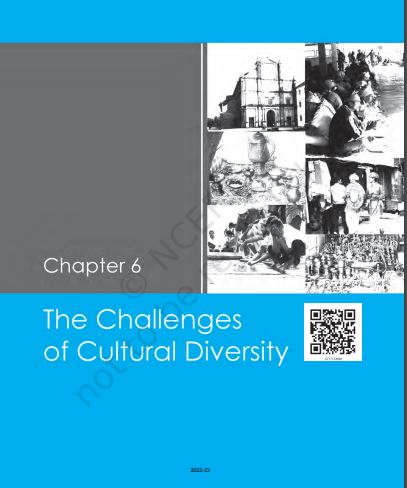‘The Challenges Of Cultural Diversity NCERT Class 12 Sociology Chapter 6 Solutions‘ PDF Quick download link is given at the bottom of this article. You can see the PDF demo, size of the PDF, page numbers, and direct download Free PDF of ‘Ncert Class 12 Sociology Chapter 6 Exercise Solution’ using the download button.
The Challenges Of Cultural Diversity NCERT Textbook With Solutions Book PDF Free Download

Chapter 6: The Challenges Of Cultural Diversity
Every human being needs a sense of stable identity to operate in this world. Questions like — Who am I? How am I different from others? How do others understand and comprehend me?
What goals and aspirations should I have? – constantly crop up in our life right from childhood.
We are able to answer many of these questions because of the way in which we are socialised, or taught how to live in society by our immediate families and our community in various senses. (Recall the discussion of socialisation in your Class XI textbooks.)
The socialization process involves a continuous dialogue, negotiation, and even struggle against significant others (those directly involved in our lives) like our parents, family, kin group and our community.
Our community provides us the language (our mother tongue) and the cultural values through which we comprehend the world. It also anchors our self-identity.
Community identity is based on birth and ‘belonging’ rather than on some form of acquired qualifications or ‘accomplishment’. It is what we ‘are’ rather than what we have ‘become’.
We don’t have to do anything to be born into a community – in fact, no one has any choice about which family or community or country they are born into.
These kinds of identities are called ‘ascriptive’ – that is, they are determined by the accidents of birth and do not involve any choice on the part of the individuals concerned.
It is an odd fact of social life that people feel a deep sense of security and satisfaction in belonging to communities in which their membership is entirely accidental.
We often identify so strongly with communities we have done nothing to ‘deserve’ – passed no exam, demonstrated no skill or competence…
This is very unlike belonging to, say, a profession or team. Doctors or architects have to pass exams and demonstrate their competence.
Even in sports, a certain level of skill and performance are a necessary pre-condition for membership in a team.
But our membership in our families or religious or regional communities is without preconditions, and yet it is total.
In fact, most ascriptive identities are very hard to shake off; even if we choose to disown them, others may continue to identify us by those very markers of belonging.
A second feature of ascriptive identities and community feeling is that they are universal.
Everyone has a motherland, a mother tongue, a family, a faith… This may not necessarily be strictly true of every individual, but it is true in a general sense. And we are all equally committed and loyal to our respective identities.
Once again it is possible to come across people who may not be particularly committed to one or the other aspect of their identity.
But the possibility of this commitment is potentially available to most people. Because of this, conflicts that involve our communities (whether of nation, language, religion, caste or region) are very hard to deal with.
Each side in the conflict thinks of the other side as a hated enemy, and there is a tendency to exaggerate the virtues of one’s own side as well as the vices of the other side.
Thus, when two nations are at war, patriots in each nation see the other as the enemy aggressor; each side believes that God and truth are on their side.
In the heat of the moment, it is very hard for people on either side to see that they are constructing matching but reversed mirror images of each other.
| Author | NCERT |
| Language | English |
| No. of Pages | 28 |
| PDF Size | 5.3 MB |
| Category | Sociology |
| Source/Credits | ncert.nic.in |
NCERT Solutions Class 12 Sociology Chapter 6 The Challenges Of Cultural Diversity
1.What is meant by cultural diversity? Why is India considered to be a very diverse country?
Ans. • The term diversity implies differences rather than inequalities.
•When we say that India is a nation of great cultural diversity, we mean that there are many different types of social groups and communities living here.
•Different types of social groups and communities live here. There are communities with different cultural markers like language, religion, sect, race or caste.
•India is a pluralistic society. There is unity in diversity but its excessive diversity is becoming a challenge.
•When diverse communities (linguistic communities, religious communities, sects and so on) are, also, a part of a larger entity like a nation, then difficulties may be created by competition or conflict between them.
•Cultural diversity can present challenges which arise from the fact that cultural identities are very powerful-they can arouse intense passions and are often able to mobilize large numbers of people.
•Sometimes, cultural differences are accompanied by economic and social inequalities and this further complicates things.
•Measures to address the inequalities or injustices suffered by one community can provoke opposition from other communities.The situation gets worse when scarce resources like water, jobs or government funds have to be shared.
•1632 different languages and dialects, different religions, diversity in climatic conditions and topography are causing serious challenges to the country.
2. What is community identity and how is it formed?
Ans. 1.Community identity is based on birth and belonging rather than on some forms of acquired qualifications or accomplishments.
2.These kind of identities are called ascriptive i.e. they are determined by birth and individual’s choice is not involved.
3.People feel a deep*sense of security and satisfaction in belonging to communities.
4.Ascriptive identities such as community identities are difficult to shake off; even if we choose to disown them, others may continue to identify us by those very markers of belonging.
5.Expanding and overlapping circles of community ties like family, kinship, ethnicity, language give meaning to our world and gives us a sense of identity.
6.Ascriptive identities and community feelings are universal. Everyone has a motherland, a mother tongue, a family, a faith. And we all are equally committed to our respective identities.
7.Our community provides us with our mother-tongue and the cultural values through which we comprehend the world. It, also, anchors our self-identity.
8. The process of socialization involves continuous dialogue with our significant surroundings such as parents, kin, family and community. Thus, community is a very important part of our identity.
9. Community conflicts are very hard to deal with since each side thinks of the other side as a hated enemy and there is a tendency to exaggerate the virtues of one’s own side as well as the vices of the other side.
10.It is very hard for people on either side to sec that they are constructing matching but reversed mirror images of each other.
11.At times, both sides are indeed equally wrong or right; at other times, history may judge one side to be the aggressor and the other to be the victim.
12.But this can happen long after the heat of the conflict has cooled down.
13.Some notion of a mutually agreeable truth is hard to arrive at in situations if identity conflict.
3. Why is it difficult to define the nation? How are nation and state-related in modem society?
Ans. • A nation is a peculiar sort of community that is easy to describe but hard to define.
•We can describe many nations founded on the basis of common cultural, historical institutions like a shared religion, language, ethnicity, history or regional culture.
•But it is hard to come up with any defining features for nation.
•For every possible criterion there are exceptions and counterexamples.
•For example-there are many nations that do not share a common language, religion, ethnicity and so on. On the other hand, there are many languages, religions or ethnicities that are shared across nations. But this does not lead to the transformation of a single unified nation.
Nation at the simplest level, is a community of communities. Members of a nation share the desire to be a part of the same political collectivity. Nations are communities that have a state of their own.
•In modem times, there has been a one-to-one bond between nation and state. But this development is new.
•It wasn’t true of the past that a single state could represent a single nation or every nation must have its own state.
•For example, Soviet Union explicitly recognized that the peoples it governed were of different nations.
•Also, people constituting a nation may actually be citizens or residents of different states. There are more Jamaicans living outside Jamaica than in Jamaica.
•Dual citizenship could, also, be a possibility. These laws allow citizens of a particular state to also simultaneously be citizens of another state. Example, Jewish AmericansMnay be citizens of Israel as well as the USA.
•Thus, nation is a community that has been able to acquire a state of its own. It‘s, also seen that states are finding it more and more necessary to claim that they represent a nation.
•A feature of the modem era is the establishment of democracy and nationalism as dominant sources of political legitimacy. This implies that nation is the most accepted or proper justification for a state, while people are the ultimate source of legitimacy of the nation.
- Structural Change PDF
- Cultural Change NCERT Textbook PDF
- The Story Of Indian Democracy PDF
- Change And Development In Rural Society PDF
- Change And Development In Industrial Society PDF
NCERT Class 12 Sociology Textbook Chapter 6 The Challenges Of Cultural Diversity With Answer PDF Free Download
